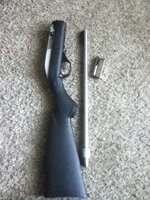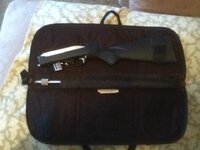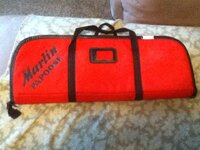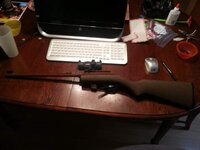Silver Supporter
Bronze Supporter
- Messages
- 4,210
- Reactions
- 6,918
REPEATABILITY:
If your purpose is for a utility gun that can be broken down for portability, and have NO intention of installing a telescopic sight, for most models repeatability is not an issue, since the buckhorn sight is most often (almost exclusively) attached to the barrel, which is a hard-component part of the take-down procedure. These guns can be disassembled, and reassembled with impunity toward accuracy concerns.
HOWEVER: If your purpose is for a .22 that can will carry a telescopic sight, and be relied upon to consistently achieve the same point of impact and accuracy after disassembly, and reassembly, it is my firm belief that the scope IMPERITAVELY needs to be attached to the barrel somehow.
Redfield solved this problem with the Browning autos, with a clever cantilever/bridge mount that allows the scope to remain attached to the barrel when the gun is disassembled. The dovetail mount is attached to the barrel, and has a "fly-over" that extends back over (but is not attached to) the receiver. It looks good and works flawlessly (in large part to the precision of the Browning take-down mechanism, but NOT dependent upon it). The average Browning Auto owner would probably own the gun for his whole life and never realize the minute change in point of impact on the rare occasion that he disassembled his rifle, then reassembled it, with the scope mounted on the factory receiver dovetail. It was the sticklers that knew how accurate these little guns were with their quality barrels, that noticed some (slight but significant to them) deviation in the take-down cycle.
Ruger, with their new 10-22 take-down, claims that a knurled spin nut allows for re-tightening of the take-down mechanism for wear, nearly eliminating the concern that the scope is not actually hard-wired to the barrel. I am skeptical. Videos (from gunshops who want to sell the gun) on YouTube, purporting flawless repeatability are replete with inattention to scientific and impartial testing procedures. I've noticed more than a few of these guns " slightly used" showing up on gunshow tables run by guys who seem to be accuracy fanatics. I think the fly is in the ointment here, supporting my belief that takedown guns are VERY useful and intriguing , but sights to be relied upon need to be attached to the barrel.
I would love to be proven wrong in this simple belief. I also anticipate very soon, somebody producing a "cantilever/flyover" dovetail mount for the Ruger, thus confirming my suspicions.
If your purpose is for a utility gun that can be broken down for portability, and have NO intention of installing a telescopic sight, for most models repeatability is not an issue, since the buckhorn sight is most often (almost exclusively) attached to the barrel, which is a hard-component part of the take-down procedure. These guns can be disassembled, and reassembled with impunity toward accuracy concerns.
HOWEVER: If your purpose is for a .22 that can will carry a telescopic sight, and be relied upon to consistently achieve the same point of impact and accuracy after disassembly, and reassembly, it is my firm belief that the scope IMPERITAVELY needs to be attached to the barrel somehow.
Redfield solved this problem with the Browning autos, with a clever cantilever/bridge mount that allows the scope to remain attached to the barrel when the gun is disassembled. The dovetail mount is attached to the barrel, and has a "fly-over" that extends back over (but is not attached to) the receiver. It looks good and works flawlessly (in large part to the precision of the Browning take-down mechanism, but NOT dependent upon it). The average Browning Auto owner would probably own the gun for his whole life and never realize the minute change in point of impact on the rare occasion that he disassembled his rifle, then reassembled it, with the scope mounted on the factory receiver dovetail. It was the sticklers that knew how accurate these little guns were with their quality barrels, that noticed some (slight but significant to them) deviation in the take-down cycle.
Ruger, with their new 10-22 take-down, claims that a knurled spin nut allows for re-tightening of the take-down mechanism for wear, nearly eliminating the concern that the scope is not actually hard-wired to the barrel. I am skeptical. Videos (from gunshops who want to sell the gun) on YouTube, purporting flawless repeatability are replete with inattention to scientific and impartial testing procedures. I've noticed more than a few of these guns " slightly used" showing up on gunshow tables run by guys who seem to be accuracy fanatics. I think the fly is in the ointment here, supporting my belief that takedown guns are VERY useful and intriguing , but sights to be relied upon need to be attached to the barrel.
I would love to be proven wrong in this simple belief. I also anticipate very soon, somebody producing a "cantilever/flyover" dovetail mount for the Ruger, thus confirming my suspicions.

















